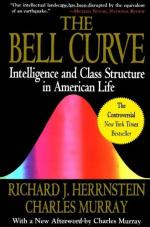|
This section contains 336 words (approx. 1 page at 400 words per page) |

|
Chapter 5, Poverty, Chapter 6, Schooling Summary and Analysis
Many people believe that poverty results from being born into poverty. The authors acknowledge that this is somewhat true, as those who grow up in the bottom 5% of socioeconomic circumstances will end up in poverty eight times more often than those in the top 5%. Yet low IQ is an even stronger predictor. If you have an IQ in the bottom 5%, you are fifteen times more likely to end up in poverty than someone in the top 5%. It is clear from the data that intelligence primarily drives poverty.
If you are born into poverty with an IQ of 100, you have a 90% chance of being out of poverty by your early 30s. Intelligence is the most important predictor of poverty, with marital status a close second. Those who are smart and well-educated are basically never impoverished, yet...
(read more from the Chapter 5, Poverty, Chapter 6, Schooling Summary)
|
This section contains 336 words (approx. 1 page at 400 words per page) |

|




